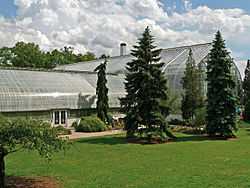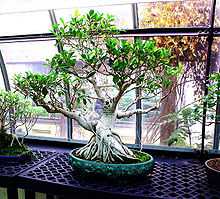Krohn Conservatory
| Krohn Conservatory at Eden Park | |
|---|---|
 Krohn Conservatory in Eden Park | |
| Type | Conservatory |
| Created | 1933 |
| Operated by | City of Cincinnati Park Board |
| Visitors | 300,000 |
The Irwin M. Krohn Conservatory is a conservatory located in Eden Park within Cincinnati, Ohio in the United States.
History
The conservatory was completed in 1933, replacing smaller greenhouses that had stood in Eden Park since 1894.[1] Originally known only as the Eden Park Greenhouse, in 1937 it was renamed in honor of Irwin M. Krohn, who served as Board of Park Commissioner[2] from 1912 to 1948. The architect firm Rapp & Meacham designed the conservatory in the Art Deco style, in the form of a Gothic arch.[3][4]
A 1966 hailstorm caused extensive damage to the conservatory, and the firm of Lord & Burnham was called to restore it.[5] The original wooden sashes were replaced with durable aluminum.[6]
Collection
It contains more than 3,500 plant species from all over the world,[7] with principal collections as follows:
- Bonsai Collection - a collection of bonsai trees from the conservatory itself, the Bonsai Society of Greater Cincinnati, and private individuals.
- Desert Garden - succulents and cacti[8] including agaves, aloes, crassulas, and yuccas, as well as cereus, opuntia, and pereskia.
- Floral Display - home to six seasonal floral shows, with a permanent citrus tree collection of orange, kumquat, giant Ponderosa lemon, and grapefruit.
- Orchid Display - approximately 75 blooming orchids at any time, from the conservatory's collection of thousands of orchids encompassing 17 genera. This display also includes a Monstera deliciosa.
- Palm House - a 45-foot (14 m) high central house with palm trees, rubber trees, and bananas, shrubby plants, and ground cover, as well as a 20-foot (6.1 m) waterfall[9] with a goldfish stream. Epiphytic bromeliads, orchids, and ferns grow in many of the trees.
- Tropical House - a large variety of ferns,[10] both terrestrial and epiphytic; cycad, bromeliad, and begonia collections; and important economic plants including a cacao tree, Pomegranate, vanilla vine, and dwarf banana.
Gallery
|
References
- ↑ Grace, Kevin (2002). "Cincinnati Revealed: A Photographic Heritage of the Queen City". Arcadia Publishing. p. 94. Retrieved 2013-06-05.
- ↑ Recchie, Nancy (2010). "Cincinnati Parks and Parkways". Arcadia Publishing. p. 74. Retrieved 2013-06-02.
- ↑ McPherson, Alan (2009). "Botanic Gems Indiana Public Gardens: Including Greater Chicago, Dayton, Cincinnati & Louisville". AuthorHouse. p. 112. Retrieved 2013-06-02.
- ↑ Federal Writers' Project (1943). "Cincinnati, a Guide to the Queen City and Its Neighbors". p. 281. Retrieved 2013-06-02.
- ↑ Bennett, Paul (Jul 1, 2000). "The Garden Lover's Guide to the Midwest". Princeton Architectural Press. p. 35. Retrieved 2013-06-04.
- ↑ Bennett, Paul (Jul 1, 2000). "The Garden Lover's Guide to the Midwest". Princeton Architectural Press. p. 35. Retrieved 2013-06-02.
- ↑ York, Tamara (Aug 24, 2009). "Eden Park Hike". Cincinnati CityBeat. Retrieved 2013-06-02.
- ↑ John H. Russell & Thomas S. Spencer (Jul 28, 2005). "Gardens Across America, East of the Mississippi: The American Horticulatural Society's Guide to American Public Gardens and Arboreta". Taylor Trade Publishing. p. 307. Retrieved 2013-05-08.
- ↑ Smith, Steve et al (2007). "A Cincinnati For the Senses". Cincinnati USA City Guide. Cincinnati Magazine. p. 12. Retrieved 2013-05-06.
- ↑ John H. Russell & Thomas S. Spencer (Jul 28, 2005). "Gardens Across America, East of the Mississippi: The American Horticulatural Society's Guide to American Public Gardens and Arboreta". Taylor Trade Publishing. p. 307. Retrieved 2013-05-08.
See also
- List of botanical gardens in the United States
External links
Coordinates: 39°06′55″N 84°29′25″W / 39.11524°N 84.49040°W
_entrance.jpg)
_falls.jpg)
_walkway.jpg)
